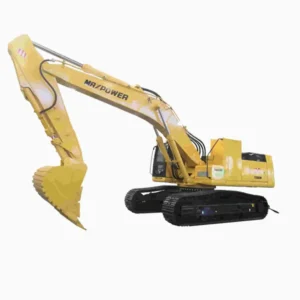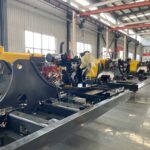Mini excavators are versatile and efficient machines that are commonly used in construction projects. With their compact size and impressive performance, they have become a staple in the construction industry. In this article, we will take a closer look at the features of a mini excavator and how they can benefit your construction project.
Table of Contents
- What is a mini excavator?
- Size and weight of mini excavators
- Engine and horsepower
- Operating weight and lifting capacity
- Digging depth and reach
- Swing radius and tail swing
- Blade and dozer capacity
- Tracks and undercarriage
- Control systems and attachments
- Cab and operator comfort
- Maintenance and durability
- Safety features
- Benefits of using a mini excavator
- How to choose the right mini excavator
- Conclusion
1. What is a mini excavator?

A mini excavator is a small and compact construction machine that is used for digging, demolition, and landscaping. It is also known as a compact excavator, and it is typically used in tight spaces where larger machines cannot operate. Mini excavators are ideal for residential and commercial construction projects where space is limited.
2. Size and weight of mini excavators
Mini excavators are designed to be small and compact, with a typical weight range of 1 to 8 tons. The size and weight of a mini excavator depend on the model and manufacturer. The compact size of mini excavators makes them easy to transport to and from the job site.
3. Engine and horsepower
Mini excavators are powered by diesel engines that range in horsepower from 10 to 70. The engine and horsepower of a mini excavator determine its performance and digging power. The higher the horsepower, the more digging power the excavator has.
4. Operating weight and lifting capacity
The operating weight of a mini excavator is the weight of the machine without any attachments or accessories. The lifting capacity is the maximum weight that the excavator can lift and move. The lifting capacity of a mini excavator depends on its size and weight.
5. Digging depth and reach
The digging depth of a mini excavator is the maximum depth that it can dig. The digging reach is the maximum distance that the excavator can reach. The digging depth and reach of a mini excavator depend on its size and weight.
6. Swing radius and tail swing
The swing radius of a mini excavator is the distance that the excavator can swing from side to side. The tail swing is the distance that the back of the excavator swings out when it turns. The swing radius and tail swing of a mini excavator depend on its size and weight.
7. Blade and dozer capacity
Mini excavators are equipped with a blade and dozer that are used for leveling and grading. The blade and dozer capacity of a mini excavator depend on its size and weight.
8. Tracks and undercarriage
Mini excavators are equipped with tracks and an undercarriage that provide stability and traction. The tracks and undercarriage of a mini excavator depend on its size and weight.
9. Control systems and attachments

Mini excavators are equipped with a variety of control systems and attachments that enhance their performance and versatility. Control systems include joysticks, foot pedals, and touchscreens. Attachments include buckets, hammers, and augers.
10. Cab and operator comfort
The cab of a mini excavator is where the operator sits. It is designed to provide comfort and safety to the operator. The cab may include air conditioning, heating, and a suspension seat to reduce operator fatigue. The operator’s comfort is essential for the safety and efficiency of the project.
11. Maintenance and durability
Mini excavators require regular maintenance to ensure their performance and longevity. The maintenance includes oil changes, filter replacements, and inspections. The durability of a mini excavator depends on its quality, design, and construction. Quality materials and superior design ensure the machine’s durability and long service life.
12. Safety features
Mini excavators are equipped with several safety features to protect the operator and the surrounding environment. The safety features include a rollover protection system (ROPS), falling object protection system (FOPS), backup cameras, and audible alarms. These safety features prevent accidents and injuries on the job site.
13. Benefits of using a mini excavator
Using a mini excavator in construction projects provides several benefits, including:
- Easy maneuverability in tight spaces
- Increased productivity and efficiency
- Reduced labor costs
- Reduced environmental impact
- Enhanced safety and operator comfort
14. How to choose the right mini excavator
Choosing the right mini excavator for your construction project requires careful consideration of several factors, including:
- Size and weight
- Engine horsepower
- Operating weight and lifting capacity
- Digging depth and reach
- Swing radius and tail swing
- Blade and dozer capacity
- Tracks and undercarriage
- Control systems and attachments
- Cab and operator comfort
- Maintenance and durability
- Safety features
15. Conclusion
Mini excavators are versatile and efficient machines that provide several benefits in construction projects. They are designed to be small and compact, making them ideal for tight spaces. Mini excavators come in different sizes and weights, with varying features and capabilities. Choosing the right mini excavator requires careful consideration of several factors, including the project requirements and the machine’s features. Investing in a quality mini excavator can enhance your project’s productivity, efficiency, and safety.
FAQs
- What is the price range of a mini excavator?
- The price range of a mini excavator varies depending on its size, weight, and features. The average price range is between $30,000 and $90,000.
- Can a mini excavator be used for landscaping?
- Yes, mini excavators are commonly used for landscaping, such as digging trenches, grading, and leveling.
- How often should I perform maintenance on my mini excavator?
- Mini excavators require regular maintenance, typically every 250 hours of use or at least once a year.
- What is the maximum digging depth of a mini excavator?
- The maximum digging depth of a mini excavator depends on its size and weight, with a typical range of 6 to 15 feet.
- How can I transport a mini excavator to and from the job site?
- Mini excavators can be transported on a trailer or a truck. It is important to ensure that the transport vehicle can handle the weight and size of the excavator.






-150x150.webp)
